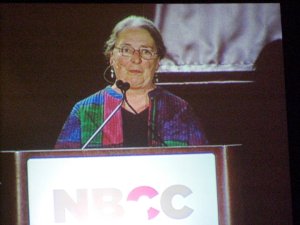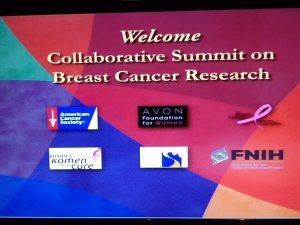These were comments I gave during the opening plenary session on the breast cancer world in 2013. My presentation followed presentations by Dr. Silvia Formenti, Dr. Susan Love, and Dr. Dennis Slamon and our session was moderated by advocate Amy Bonoff.

Good morning. So we’ve heard a lot about where we are today with breast cancer, and a little bit about where we need to go. It’s clear that a lot needs to change. Over 300,000 women will be diagnosed this year with in situ or invasive breast cancer but at least one third of those women will have been overdiagnosed, put at risk of toxicities from treatments they didn’t need. And though screening has led to an increase in the diagnosis of early breast cancer, particularly DCIS, the rate of those diagnosed with Stage IV disease has not declined, but instead has been holding steady at the same rate for the past 30 years. I would tell you the rate of women diagnosed with recurrences every year, but I don’t know. It’s not tracked. But I do know that the median survival for all women with metastatic breast cancer has also remained constant, at about three years.
The good news is that we are preventing some recurrences – we have seen steady, incremental declines in breast cancer mortality since the early 90s – but the bad news is we don’t really know why. We do not know how to save the lives of individual women. The overall picture of recurrences is murky, we don’t know much. As I said, we don’t track these women. It’s like the world wants to ignore the true nature of breast cancer, a disease that can hide out for a few years or many before reappearing. No medical oncologist can truthfully tell an individual woman how to prevent a recurrence, or if she is indeed “cancer free” once she has had a diagnosis of breast cancer. As patients ourselves and watching our friends, I think most of us would agree, it feels like a crap shoot. Good luck or bad luck.
And so there is much that must change. We need fewer women being diagnosed with breast cancer in the first place. We need to understand prevention, prevention of lethal disease, and just as importantly, we need to understand how to prevent those with non-lethal disease from being brought into the system, lowering their quality of life, putting them at risk for toxicities needlessly, some of those toxicities deadly, and straining the health care system with increased costs. And we need to understand how to prevent recurrences and metastasis. So much focus is on the primary disease, ignoring the fact that the majority of women die of metastasis, and most of those experienced metastasis after a recurrence.
So why has so little changed? I’ve spent a lot of time thinking about this, and I think it is because the world of breast cancer has grown exponentially, explosively, and in so many directions, way beyond the disease itself. So many people have become invested in breast cancer and everything surrounding it, way beyond the patients themselves. All of this attention has caused distraction, misguided focus in the wrong places, and worse yet, brought tremendous investment in the status quo.
Because breast cancer has garnered a lot of attention it has attracted so many people to attach to it – many businesses have thrived directly, mammography providers, biopsy device businesses, hospitals, pharmaceutical companies, oncologists, to name a few. And then there are businesses with no direct connection but that use cause marketing to drive profits, or to counteract bad PR, and this is where we get more bizarre partnerships each year – we can vacuum, pump gas, drink hard liquor, and bake for the cure. Breast cancer is the mother of all cause marketing.
But then we also have scientists who are pursuing new knowledge about cells, genetics or biochemistry, whatever their interest, which is great – but they know there can be good avenues for their funding if they somehow link their interests to breast cancer, and they do. And non-profits with various agendas find ways to link their cause to breast cancer, knowing concern about breast cancer will drive their own influence and fundraising. Politicians even get into the act for the women’s vote, whether they help light up pink bridges or express outrage at new mammography guidelines, they can show their support for women’s issues.
Breast cancer is so much more than a disease, it is an industry, a feel good cause, a fear for all women, an inspirational journey for women’s magazines. In fact, I would argue, you couldn’t dream up a better consumer situation for profit and growth with strong forces for maintenance and keeping the status quo. Let me see if I can explain what I mean:
With breast cancer we have half the population at risk, the half that is most compliant, most likely to defer to authority. They are at risk of something that is very scary, that can take away so much, parts of the body, sexual identity, hair, and worst of all life. They are constantly reminded of that risk when they shop, go online, read a magazine. They have very little reliable information about the causes of breast cancer, so it will seem almost random, creating great anxiety and fear, and creating a great market for doing something, anything, to protect oneself and to contribute to a cure.
That fear, the compliance, the trust of authority all leaves women vulnerable to overdiagnosis and overtreatment, but is a boon for business.
Think about treatment decisions. Women are the caretakers. We are willing to take it all, add it on, add it up, give me everything, anything that contributes one iota to more time with our families. At whatever the cost, to ourselves, our bodies, our bank accounts, no matter how small the promise of benefit.
And then the disease itself contributes by being so complex; it is not one disease, though portrayed as if it is to the public. There is no easy answer. There is tremendous opportunity for scientists, who are in the business of discovery, of finding something new, exploring the seemingly infinite number of mutations and pathways associated with breast cancer. The more we learn, the more it seems that each individual tumor is unique, with its’ own unique fingerprint, most likely unique causes, and most definitely unique responses to treatment. And these tumors aren’t frozen in time, but continue to evolve and change. A fascinating playing field for science. No question, a lot of resources dedicated to discovery in breast cancer, but not so much in translation to the clinic. And, not so much to discovery upstream, earlier on in the disease or in the normal breast, the kind of discovery that could lead to prevention of the disease. But who does that benefit besides our daughters?
So much change is needed. Don’t get me wrong, there are many hardworking, dedicated people focused on making positive change for women and future generations. But they often face difficult challenges within the system. So this is where you all come in. WE, all of us together, can be one strong, powerful voice calling for change.
And so now I want to talk a little bit about breast cancer advocacy. Where we have been and where we need to go.
First of all, what is an advocate? An advocate is defined as someone who speaks, writes, or stands up for something or someone; someone who supports or promotes the interests of another.
In the early days of breast cancer advocacy, this is exactly what was done. There was a need to bring attention to the disease, bring it out of the closet. And this was done successfully. Women can speak openly and freely about the disease. But advocates went on to do so much more than this, speaking out about the needs of breast cancer patients. And in particular NBCC advocates, spoke out and were successful in obtaining increased access to medical care for women with breast cancer, and increased federal research funding directed at the disease. Scores of women and men have been empowered and educated, and now have a seat at the table where decisions are being made that impact those with breast cancer.
But now we need to kick it up a notch. We need to be the advocates for change in the breast cancer world. We must see ourselves as not only advocates, but activists, defined as those who take direct, vigorous action to bring change.
You as our leaders must understand this better than anyone. Breast cancer advocacy has become diluted by so many who seek to use advocates to promote their own agenda. Be wary of who or what you are advocating for when you are recruited as a breast cancer advocate. Put the task through the BCD2020 lens. Am I seeking change here? Will this contribute to ending breast cancer? Or am I contributing to the status quo? Things have gone awry in the breast cancer world and we, as activists, must seek to turn things around, seeking change rather than protecting the status quo. We need to demand more focused research with the end results in mind. We need more translational research. We need to focus more upstream, even to the normal breast, so we can understand prevention. And we need to measure what matters. And that is what this Summit is all about. We will be learning, we will be brainstorming new ideas, and we will be making plans for that direct, vigorous action that will bring change.
And I want to end with the positive. We do have some of this happening already. Particularly, with NBCC’s Artemis Projects, we are demanding focused research with the end results in mind. These are experiments that will try out a new way of doing things, and hopefully be a model for others. We will have an opportunity to hear about some of these efforts in the next session. But we have only just begun. And we need so much more to happen. We are counting on all of you to work with us to help make it happen. So let’s get it done.



